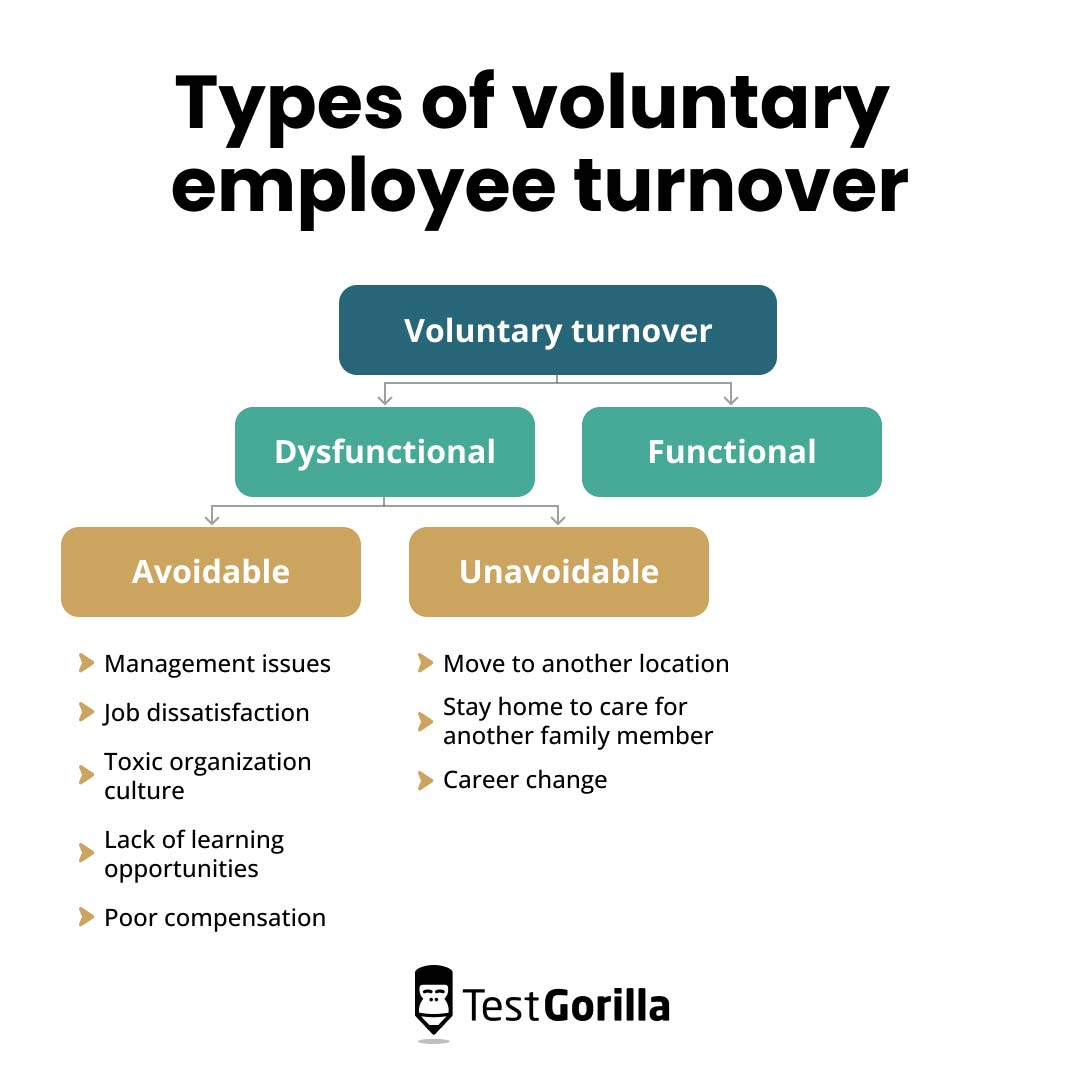An employee choosing to leave your organization can be a bit like being dumped. Sometimes you see it coming and even consider it a mutual decision; other times, it’s painful and hard to recover from.
Reducing voluntary turnover and especially minimizing the latter scenario is one of the most important HR management skills.
That’s why in this blog, we show you how to reduce voluntary turnover in your business, equipping you with 35 employee retention strategies, trends, and tips to tackle it.
We also cover the key reasons for voluntary turnover and whether or not high voluntary turnover is always a bad thing.
Let’s start with the basics. If you’re already familiar with the different types and costs of voluntary turnover, you can skip straight to the tips.
Table of contents
What is voluntary turnover?
Voluntary turnover occurs when an employee leaves their role by choice instead of having their employment terminated by the company.
It can happen for many reasons, including:
Retirement
Dissatisfaction with working conditions or management
Lack of promotion opportunities
Seeking a career change
Relocating to a new city
Voluntary vs. involuntary turnover
Involuntary turnover is the reverse of voluntary turnover. Instead of employees choosing to leave their roles, these separations are mandated by the employer. Again, this can occur for many reasons, such as:
Poor performance
Misconduct
Redundancies
Types of voluntary turnover
There are many different types of employee turnover. Here are the ones you need to know.
Functional voluntary turnover
When we talk about voluntary turnover being “functional,” we mean with regard to your capital. In other words, it brings a benefit to your company.
The main example of voluntary functional turnover is when employees who perform poorly leave your organization and are replaced with better-performing employees, bringing value to your workforce.
Dysfunctional voluntary turnover
Dysfunctional voluntary turnover is detrimental to your workforce. This means that high-performing employees are choosing to leave, damaging your ability to function. Under this umbrella are unavoidable and avoidable turnover, which we cover next.
Unavoidable turnover
Even the strongest employers experience some voluntary turnover due to circumstances out of their control. This is known as unavoidable turnover, and it takes in reasons for voluntary turnover like:
Relocating
Caring for a family member
Changing careers
Avoidable turnover
Avoidable turnover, on the other hand, is voluntary turnover that’s within the employer’s power to change. Avoidable voluntary turnover reasons include:
Toxic culture
Lack of promotion opportunities
Poor compensation
Naturally, we mainly tackle avoidable voluntary turnover examples in this blog.
Why should you track your voluntary turnover?
Many businesses track their overall turnover rates alongside their employee retention rates. Why is it worth paying particular attention to voluntary turnover as a separate metric?
Lumping involuntary and voluntary turnover together into one metric doesn’t tell you much about the talent you’re losing or when and why you’re losing them.
If most of your employee exits are involuntary and caused by poor performance, for example, this indicates a problem with your hiring process.
If, on the other hand, they are mostly voluntary and come after a change in management, it could indicate leadership issues. A combined metric doesn’t give you this insight.
Learning how to calculate voluntary turnover and analyze your findings over time gives you insight into how much of your voluntary turnover is avoidable. With this information, you can investigate what’s causing voluntary turnover and fix problems in your business.
The 4 main causes of voluntary employee turnover
McKinsey surveyed people about why they left their jobs, and many of the reasons fell into four main buckets.[1]
Causes of voluntary turnover | Specific issue | % of employees who quit because of this |
1. Culture issues | Unwelcoming and noninclusive community | 14% |
Unreliable and unsupportive colleagues | 26% | |
2. Management issues | Unsafe working environment | 13% |
Unsustainable work expectations | 29% | |
Uncaring and uninspiring leaders | 34% | |
3. Job dissatisfaction | Lack of flexibility | 26% |
Inadequate compensation | 36% | |
Lack of career development and advancement | 41% | |
4. Disengagement | Lack of meaningful work | 31% |
This aligns with other research on voluntary employee turnover.
The key to managing voluntary turnover is identifying which of these issues are at play in your workforce, and using this information to deploy employee retention trends and strategies to tackle these core issues.
Before we get to these tips, though, let’s look at how to calculate voluntary turnover.
How to calculate your voluntary turnover rate
To calculate voluntary turnover specifically, use this voluntary turnover formula:
Employee turnover rate in a given period = number of workers who leave voluntarily during period / number of employees at the beginning of the period × 100
Here’s how to apply it.
1. Decide the period to examine
Determine the period of time you want to calculate. It’s best to do voluntary turnover calculations regularly, so you might look at intervals of:
A month
A quarter
A year
2. Gather data for the start of that period
Count the employees that were on your payroll on the first day of the period you decided on. Do not count employees who joined the company after this date, even if they joined the next day.
3. Count departing employees who left voluntarily
Count the number of original employees who are no longer on the payroll at the end of this period. This ensures you don’t count some employees twice – for example, if they tender their resignation in one quarter but don’t finish their notice period until the next.
Of this group, how many left voluntarily? Remember, this includes quitting and retiring.
Divide this figure by the number of original employees, and then multiply by 100 to calculate your voluntary turnover rate.
How to calculate voluntary turnover rate: An example
Let’s dive into what this might look like. You decide to look at your voluntary annual turnover rate in a one-year period. On January 1, you have 350 employees on the payroll.
Over the year:
10 employees retire
20 employees quit
You fire five people
You make 15 people redundant
You also hire 40 people
On December 31, you have 340 employees, 300 of whom were there at the start of the year.
30 of these (the retirees and employees who quit) count as voluntary employee turnover.
This makes your voluntary turnover formula the following: 30 / 350 × 100 = 8.5% voluntary employee turnover.
The number of new hires is not relevant, so it isn’t factored in.
But how does this stack up to other companies?
What is a good voluntary turnover rate?
Generally speaking, organizations should aim for a voluntary turnover rate of around 10%, but it’s normal for it to be higher.
iMercer research shows the average voluntary turnover rate in the US is 17.3%.[2]
For more specific benchmarks, look first at industry figures. iMercer found that retail organizations have the highest voluntary turnover rates (32%) because of the seasonal nature of many roles, whereas the energy sector has one of the lowest, 12.3%.
Voluntary turnover also differs across functions. The functions with the lowest voluntary turnover rates include:
Creative, design, and media: 3.1%
Data analytics: 4.0%
Communications and corporate affairs: 4.8%
Executives: 5.1%
The highest rates belong to sales, marketing, and product management (10%) and supply chain and transportation services (8.4%).
For an in-depth look at these rates, read our blog about how to calculate employee turnover rate.
The cost of voluntary employee turnover
The cost of employee turnover to your bottom line can be huge – one-half to twice their yearly salary, by some estimates.
These turnover costs come from many different areas, including:
Time and operating costs for hiring managers
Recruitment marketing and paying recruiters
Healthcare for burnt-out employees shouldering departed colleagues’ responsibilities
Productivity loss from gaps in the team and ramp-up periods for new employees
Potentially higher compensation and signing bonuses for new recruits
Retaining employees is the best way to avoid these costs. Retaining a salesperson for three years instead of just two can yield as much as $1.3M in net value over a three-year period.[3]
How to reduce voluntary turnover: 35 tactics for tackling the root causes
To reduce voluntary turnover, you need to address the four key causes of voluntary turnover.
This means:
Creating a culture employees don’t want to leave
Engaging employees in their work in a well-managed environment
Supporting their career growth
Stopping the cycle of dysfunctional turnover
Here are 35 tips on how to achieve these goals.
35 tactics to reduce voluntary turnover: Summary
Want to learn tips for how to reduce voluntary turnover at a glance? Here’s a list, split into which of the above priorities each tip serves.
Create a positive company culture
Hire the right people by looking for culture add
Switch to skills-based hiring to improve diversity
Prioritize creating an inclusive culture
Hire a chief experience officer
Design initiatives to improve employee well-being
Include provisions for mental health in the workplace
Take steps to improve employee work-life balance
Start by implementing flexible working
Make one-on-one meetings central to your culture
Validate employees’ work with employee recognition programs
Engage employees and managing your business effectively
Practice strong leadership communication
Draw up a clear remote work policy
Create a plan to monitor employee engagement
Use multiple systems to solicit employee feedback
Implement an “always-on” feedback tool
Build a system for upward feedback
Conduct stay interviews with remaining employees
Use HR analytics to monitor success
Give all managers diversity training
Support employees’ careers
Compensate employees competitively
Sweeten the deal with strong employee benefits
Create a plan to promote internal mobility
Input all employee skills data into an internal talent marketplace
Use this to identify candidates for upskilling
Discuss new employees’ career growth as early as possible
Offer job rotation programs for new employees to find the right fit
Design professional development plans for all employees
Use employee coaching to meet specific goals
Give employees their own budget for employee training programs
Offer reskilling programs for employees to change their careers while remaining employed
Stop the cycle of dysfunctional voluntary turnover
Smooth the transition with phased retirement plans
Conduct exit surveys with all departing employees
Leave the working relationship on good terms
Use insights from this process to identify employee flight risks
Manage the impact on your corporate reputation
1. Hire the right people by looking for culture add
The first step to creating a positive company culture is hiring the right people. The best way to do this is by testing candidates for “culture add.”
Unlike culture fit, which stresses superficial characteristics and the interviewer’s subjective opinion of the candidate, culture add tests ensure candidates align with your organization’s mission and values while bringing something new in terms of their skills or outlook.
This helps to ensure that the top talent you hire makes for a good employee, increasing job satisfaction and collaboration with team members – and reducing voluntary turnover.
2. Switch to skills-based hiring to improve diversity
Switching to a skills-based approach to talent management can also improve diversity in the workplace, which impacts retention.
Higher levels of gender diversity, combined with human resources policies focused on fair, transparent hiring practices, are linked to lower turnover.
Diversity is also consistently linked to higher business performance, which can reduce the likelihood of voluntary and involuntary turnover by avoiding layoffs.
Don’t look only at racial and gender diversity, but other kinds too – this includes neurodiversity and generational diversity.
3. Prioritize creating an inclusive culture
Boosting diversity is useless unless you also welcome marginalized employees into an inclusive culture.
This means removing barriers to progression for marginalized employees and barriers to entry. Examples of inclusive policies include:
Using inclusive language in job ads and company communications
Ensuring all employees can participate in socials and benefits (more on these later)
Providing inclusive workspaces
4. Hire a chief experience officer
To manage this overhaul of your company culture, consider hiring a chief experience officer to handle all employee experience initiatives.
This is similar to a “head of people” or “head of HR” role, except it places emphasis on the leader’s service to employees.
This person would be an advocate for employees in high-level meetings, securing budgets and designing initiatives to engage employees and lower voluntary and involuntary turnover.
5. Design initiatives to improve employee well-being
One of the areas a chief experience officer should prioritize is improving employee well-being, on the basis that happy employees are more motivated and less likely to seek employment elsewhere.
Beware of blind spots here. Don’t limit employee well-being efforts to in-person initiatives like office yoga. Make sure to include remote and hybrid workers as well.
6. Include provisions for mental health in the workplace
Supporting mental health in the workplace is non-negotiable.
More than one in 10 working-age adults struggles with their mental health. Lack of support in this area puts these workers at risk of stress and burnout and causes higher voluntary employee turnover.
Include mental healthcare in your healthcare plan and train “mental health first aiders” to create peer support networks.
7. Take steps to improve employee work-life balance
Many organizations suffering from high turnover place extra stress on remaining employees to sacrifice their leisure time to meet targets. Instead of helping, this likely intensifies existing turnover problems.
Avoid this mis-step by paying extra attention to employee work-life balance.
Set strict guidelines around out-of-hours work and ask leaders to model this by not sending or responding to work emails after 5 pm, for instance.
8. Start by implementing flexible working
Another way to improve employee work-life balance is by offering flexible work. Nearly 40% of flexible workers say they experience benefits for their mental health.
In fact, to many employees, flexible work is an even stronger incentive than a pay rise when it comes to staying with their employer. A significant 72% of office workers say they’d prefer long-term flexibility over extra money.[4]
9. Make one-on-one-meetings central to your culture
Fostering greater connections between employees is essential to improving company culture. Building a culture of one-on-one meetings can do this for managers and their direct reports, ensuring that employees feel heard.
It also gives managers opportunities to spot employee dissatisfaction before it turns into a resignation and impacts your voluntary turnover rate.
10. Validate employees’ work with employee recognition programs
When you recognize employees’ efforts at work, they are unlikely to look for a new job in the next three to six months.[5]
One of the best ways to do this is with employee recognition programs, ideally a range of them. For example:
A Slack shoutout channel for peer-to-peer recognition
Employee of the month programs
Spot bonuses
11. Practice strong leadership communication
We know that more than a third of employees quit due to uncaring and uninspiring leadership. Fix this with clear and positive leadership communication.
Research shows that providing authentic leadership – for example, by modeling fairness and explaining key business decisions – substantially improves employees’ job performance. If employees believe you are fair and honest, they are more likely to trust and follow you.[6]
12. Draw up a clear remote work policy
Offering remote work can reduce voluntary turnover by increasing flexibility. Just make sure you have a remote work policy in place.
This should set out clear expectations for remote employees. For example:
When they need to be online
Where they can work from and how long (it may affect your taxes as an employer if they work abroad for more than a month)
What equipment they need, and what you provide
13. Create a plan to monitor employee engagement
Low engagement is a clear risk factor for voluntary employee turnover. Poorly engaged teams have turnover rates up to 43% higher than their highly engaged colleagues.[7]
Create a plan to monitor employee engagement through multiple metrics, such as:
Employee performance
Absenteeism
Employee feedback
Speaking of which…
14. Use multiple systems to solicit employee feedback
Listening to employee feedback shows employees that you care about their experience, and it helps diagnose the issues behind avoidable voluntary turnover.
Put multiple systems in place to collect:
Short-term, spontaneous feedback about employees’ day-to-day experience
Medium-term feedback, like reflecting on a recent change in management
Long-term feedback reflecting on broad changes in the last year or the overall running of the company
15. Implement an “always-on” feedback tool
Consider collecting employee feedback through an “always-on” employee listening tool.
We know this sounds like spyware, but in fact, it’s a simple portal that is always available for employees to log spontaneous feedback.
Over two-thirds of HR leaders say this kind of tool is essential to their engagement listening programs.
16. Build a system for upward feedback
It’s hard to enact lasting change in your organization unless employee feedback makes its way to the top of your corporate structure. (This is why a chief experience officer can be such an asset!)
Build a system for upward feedback with junior employees voicing concerns to management. For example, you might pair junior employees with senior leaders in a reverse mentoring program.
17. Conduct stay interviews with remaining employees
Understanding why people leave is understandably valuable when seeking to reduce voluntary turnover, but it’s also important to understand why people stay.
This is where stay interviews come in handy.
If you’re dealing with a turnover crisis, conduct stay interviews with remaining employees. Start with your low-turnover teams, investigating what’s keeping them in their roles and how you can apply this elsewhere.
18. Use HR analytics to monitor success
Of course, you can’t just set up these initiatives and hope for the best; you need to monitor them like any other business project.
HR analytics can help you here. This could be as simple as analyzing your voluntary turnover rate after you switch to skills-based hiring, or more in-depth, such as using AI to identify candidates for internal promotion.
19. Give all managers diversity training
Our final piece of management-related advice is to extend the promotion of awareness around diversity beyond your HR function. Give all managers diversity training to extend inclusive practices throughout the organization.
This takes the onus off marginalized employees to advocate for themselves and encourages managers to make proactive changes for the benefit of a diverse workforce.
20. Compensate employees competitively
As we know, more than a third of workers quit due to inadequate total compensation. Ensure you have a strong employee compensation plan in place to avoid this. This means:
Proactively offering raises, not waiting for employees to ask
Researching roles to ensure your rates are competitive within the market
Offering other perks to add extra value, like stock options
21. Sweeten the deal with strong employee benefits
Employee benefits are a great way to incentivize employees to stay on board without breaking the bank.
We’ve already seen that benefits like flexible work offerings can be more appealing than extra money to many employees. Other employee benefits to discourage employees from jumping ship include:
Generous parental leave policies
Unlimited vacation days
On-site childcare
22. Create a plan to promote internal mobility
Many employees leave because they don’t see avenues to promotion or success within your organization.
Promoting internal mobility by supporting internal hiring shows employees there are numerous options for how their careers could advance without needing to leave.
Seventy percent of employees who receive internal promotions stay on board compared with 45% of those who do not move roles internally.
23. Input all employee skills data into an internal talent marketplace
An invaluable tool in increasing internal mobility is an internal talent marketplace. This is a software or simple spreadsheet that shows you the skills resources in your organization, and you can “shop” for potential candidates the next time there’s an open role.
To maximize its effectiveness, fill this marketplace with the skills data you collect during hiring.
24. Use this to identify candidates for upskilling
The overview of your skills resources that an internal talent marketplace gives you can surface candidates for upskilling.
There are probably more of these than you think. In the US, one-third of workers don’t have all the digital skills they need to succeed in today’s work marketplace.[8]
Identify employees whose skill sets have weak points and suggest training opportunities. This shows your investment in your employees and helps earn their loyalty and respect.
25. Discuss new employees’ career growth as early as possible
We know this sounds counterintuitive, but to reduce voluntary turnover, you should acknowledge to employees that their career growth might eventually take them out of your organization.
According to experts at the Harvard Business Review, the best time for this conversation is the onboarding process.[9]]
This honesty increases the likelihood of employees giving you a heads-up if they’re thinking of leaving – reducing the negative effects of voluntary turnover.
26. Offer job rotation programs for new employees to find the right fit
Voluntary employee turnover is to be expected from early-career employees as they figure out what the right career path for them is. You can help them do this and reduce voluntary turnover by providing job rotation programs.
These are initiatives whereby employees within the same department and seniority level “rotate” between different functions to find the right fit.
27. Design professional development plans for all employees
The top reason employees leave their jobs is a lack of learning and development opportunities.[10]
Show employees your intent to develop their skills by designing professional development plans for them. These should outline their career goals and the steps needed to meet them, including the training you can provide to help.
28. Use employee coaching to meet specific goals
To help employees tackle specific challenges – for instance, securing a promotion or mastering a new skill outside of their wheelhouse – use employee coaching.
This is similar to mentorship, but it’s more time-limited and less focused on the employee, drawing insights from the coach’s own career experience.
29. Give employees their own budget for employee training programs
Putting employees in charge of their own learning shows trust and gives employees autonomy over their career development.
At TestGorilla, we invest in our employees’ career growth by giving them the equivalent of 3% of their salary to spend on employee training programs of their choice. All they need is sign-off from their manager.
30. Offer reskilling programs for employees to change their careers while remaining employed
You might think it’s unavoidable for employees to quit if they want to change careers, but this isn’t necessarily true. Offering new opportunities for reskilling can conserve valuable institutional knowledge while enabling employees to pursue a new career path.
“Reskilling” refers to training an employee in skills that are not directly relevant to their current role, with the hope of moving them into a different one.
It’s a smart investment. Half of hiring managers anticipate technological interventions like workplace automation to change the kinds of skills they need from employees.
31. Smooth the transition with phased retirement plans
Even if you implement all of these initiatives, some voluntary employee turnover is inevitable. Managing voluntary turnover when it happens is important to avoid “turnover contagion.”
One way to do this is with phased retirement programs. These smooth the transition for retirees and the teams they leave behind, allowing a period for handover and extending your window for hiring a replacement.
32. Conduct exit surveys with all departing employees
You should also conduct exit surveys with all departing employees, not just the ones you’d be happy to see return. Ask tough questions like:
What led you to start searching for a new job?
What did you like best and least about your job and this company?
Do you think your job has changed since you were hired?
Do you feel you were given adequate support, resources, and tools to succeed in your job?
33. Leave the working relationship on good terms
Your exit interviews are also a good opportunity to leave the working relationship on good terms and manage your reputation.
For example, you could invite departing employees to join an “alumni group” where they can see the latest insights from your company and receive notifications about future positions.
Many large organizations have alumni portals in place, including Deloitte.
34. Use insights from this process to identify employee flight risks
Use a combination of the data you’ve gathered throughout this process to identify employee flight risks. These might be employees whose:
Absenteeism has risen
Participation in training programs has dropped
Employee feedback reflects similar gripes to departing employees
Once you’ve identified them, intervene to re-engage them before they drive up voluntary turnover.
35. Manage the impact on your corporate reputation
All of these tips help you manage your corporate reputation even amid a spike in voluntary turnover.
This helps reduce the likelihood of further voluntary turnover by maintaining your reputation as a company employees are proud to work for.
Other ways you can do this include:
Responding generously to Glassdoor reviews, even ones that contain criticism
Leaving positive recommendations for departing employees on LinkedIn
Using positive recruitment marketing to attract more culture add candidates to your workplace
Skills testing is your secret weapon in reducing voluntary turnover
In this blog, we’ve explored all aspects of voluntary employee turnover, from the voluntary turnover definition to managing voluntary turnover when it happens.
We’ve seen how important it is to employees to advance their skills – and that they’ll go to another employer if that’s what it takes to do it.
We’ve also seen how an employer’s focus on skills can benefit their workforce’s diversity, productivity, and retention.
Now it’s time to translate these insights into action.
Start by reading our guide to reducing employee turnover with skills tests, and hang on to your team. Or dive straight in by exploring our test library.
Sources
1. De Smet, Aaron, et al. (July 18, 2022). “The Great Attrition is making hiring harder. Are you searching the right talent pools?”. McKinsey & Company. Retrieved December 11, 2023. https://www.mckinsey.com/capabilities/people-and-organizational-performance/our-insights/the-great-attrition-is-making-hiring-harder-are-you-searching-the-right-talent-pools
2. “Results of the 2023 US and Canada Turnover Surveys”. (September 21, 2023). iMercer. Retrieved December 11, 2023. https://www.imercer.com/articleinsights/workforce-turnover-trends
3. Josebachvili, Maia. (August 29, 2016). “How to understand the ROI of investing in People”. LinkedIn. Retrieved December 11, 2023. https://www.linkedin.com/pulse/how-understand-roi-investing-people-maia-josebachvili/
4. “Why Employees Prefer Hybrid Working To A 10% Pay Rise – And What It Means For Business”. (September 13, 2021). International Workplace Group. Retrieved December 11, 2023. https://old.iwgplc.com/MediaCentre/Article/why-employees-prefer-hybrid-working-to-pay-rise
5. Des Georges, Colette. (2019). “Can employee recognition help you keep them longer?”. SurveyMonkey. Retrieved December 11, 2023. https://www.surveymonkey.com/curiosity/employee-recognition-and-retention/
6. Ayca, Betul. (April 2023). “Association between Authentic Leadership and Job Performance—The Moderating Roles of Trust in the Supervisor and Trust in the Organization: The Example of Türkiye”. Sustainability. Retrieved December 11, 2023. https://www.researchgate.net/publication/370020488_Association_between_Authentic_Leadership_and_Job_Performance-The_Moderating_Roles_of_Trust_in_the_Supervisor_and_Trust_in_the_Organization_The_Example_of_Turkiye
7. “The Benefits of Employee Engagement”. (January 7, 2023). Gallup. Retrieved December 11, 2023. https://www.gallup.com/workplace/236927/employee-engagement-drives-growth.aspx
8. Mello, John P. (November 30, 2021). “Report Finds US Workers Lagging in Digital Skills”. TechNewsWorld. Retrieved December 11, 2023. https://www.technewsworld.com/story/report-finds-us-workers-lagging-in-digital-skills-87352.html
9. Dachner, Alison M; Makarius, Erin E. (April 2021). "Turn Departing Employees into Loyal Alumni". Harvard Business Review. Retrieved December 11, 2023. https://hbr.org/2021/03/turn-departing-employees-into-loyal-alumni
10. “2019 Retention Report”. (2019). Work Institute. Retrieved December 11, 2023. https://info.workinstitute.com/hubfs/2019%20Retention%20Report/Work%20Institute%202019%20Retention%20Report%20final-1.pdf
Related posts
Hire the best candidates with TestGorilla
Create pre-employment assessments in minutes to screen candidates, save time, and hire the best talent.
Latest posts
The best advice in pre-employment testing, in your inbox.
No spam. Unsubscribe at any time.

Hire the best. No bias. No stress.
Our screening tests identify the best candidates and make your hiring decisions faster, easier, and bias-free.
Free resources
This checklist covers key features you should look for when choosing a skills testing platform
This resource will help you develop an onboarding checklist for new hires.
How to assess your candidates' attention to detail.
Learn how to get human resources certified through HRCI or SHRM.
Learn how you can improve the level of talent at your company.
Learn how CapitalT reduced hiring bias with online skills assessments.
Learn how to make the resume process more efficient and more effective.
Improve your hiring strategy with these 7 critical recruitment metrics.
Learn how Sukhi decreased time spent reviewing resumes by 83%!
Hire more efficiently with these hacks that 99% of recruiters aren't using.
Make a business case for diversity and inclusion initiatives with this data.
























